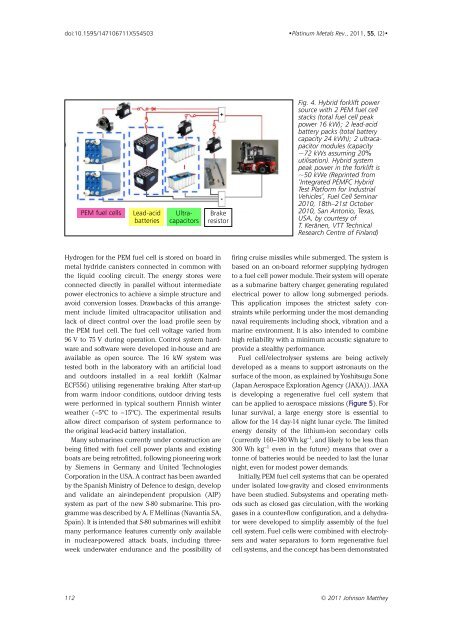Download - Platinum Metals Review
Download - Platinum Metals Review
Download - Platinum Metals Review
You also want an ePaper? Increase the reach of your titles
YUMPU automatically turns print PDFs into web optimized ePapers that Google loves.
doi:10.1595/147106711X554503<br />
•<strong>Platinum</strong> <strong>Metals</strong> Rev., 2011, 55, (2)•<br />
PEM fuel cells<br />
Lead-acid<br />
batteries<br />
Ultracapacitors<br />
Brake<br />
resistor<br />
Fig. 4. Hybrid forklift power<br />
source with 2 PEM fuel cell<br />
stacks (total fuel cell peak<br />
power 16 kW); 2 lead-acid<br />
battery packs (total battery<br />
capacity 24 kWh); 2 ultracapacitor<br />
modules (capacity<br />
~72 kWs assuming 20%<br />
utilisation). Hybrid system<br />
peak power in the forklift is<br />
~50 kWe (Reprinted from<br />
‘Integrated PEMFC Hybrid<br />
Test Platform for Industrial<br />
Vehicles’, Fuel Cell Seminar<br />
2010, 18th–21st October<br />
2010, San Antonio, Texas,<br />
USA, by courtesy of<br />
T. Keränen, VTT Technical<br />
Research Centre of Finland)<br />
Hydrogen for the PEM fuel cell is stored on board in<br />
metal hydride canisters connected in common with<br />
the liquid cooling circuit. The energy stores were<br />
connected directly in parallel without intermediate<br />
power electronics to achieve a simple structure and<br />
avoid conversion losses. Drawbacks of this arrangement<br />
include limited ultracapacitor utilisation and<br />
lack of direct control over the load profile seen by<br />
the PEM fuel cell. The fuel cell voltage varied from<br />
96 V to 75 V during operation. Control system hardware<br />
and software were developed in-house and are<br />
available as open source. The 16 kW system was<br />
tested both in the laboratory with an artificial load<br />
and outdoors installed in a real forklift (Kalmar<br />
ECF556) utilising regenerative braking. After start-up<br />
from warm indoor conditions, outdoor driving tests<br />
were performed in typical southern Finnish winter<br />
weather (−5ºC to −15ºC). The experimental results<br />
allow direct comparison of system performance to<br />
the original lead-acid battery installation.<br />
Many submarines currently under construction are<br />
being fitted with fuel cell power plants and existing<br />
boats are being retrofitted, following pioneering work<br />
by Siemens in Germany and United Technologies<br />
Corporation in the USA. A contract has been awarded<br />
by the Spanish Ministry of Defence to design, develop<br />
and validate an air-independent propulsion (AIP)<br />
system as part of the new S-80 submarine. This programme<br />
was described by A. F. Mellinas (Navantia SA,<br />
Spain). It is intended that S-80 submarines will exhibit<br />
many performance features currently only available<br />
in nuclear-powered attack boats, including threeweek<br />
underwater endurance and the possibility of<br />
firing cruise missiles while submerged. The system is<br />
based on an on-board reformer supplying hydrogen<br />
to a fuel cell power module. Their system will operate<br />
as a submarine battery charger, generating regulated<br />
electrical power to allow long submerged periods.<br />
This application imposes the strictest safety constraints<br />
while performing under the most demanding<br />
naval requirements including shock, vibration and a<br />
marine environment. It is also intended to combine<br />
high reliability with a minimum acoustic signature to<br />
provide a stealthy performance.<br />
Fuel cell/electrolyser systems are being actively<br />
developed as a means to support astronauts on the<br />
surface of the moon, as explained by Yoshitsugu Sone<br />
(Japan Aerospace Exploration Agency (JAXA)). JAXA<br />
is developing a regenerative fuel cell system that<br />
can be applied to aerospace missions (Figure 5). For<br />
lunar survival, a large energy store is essential to<br />
allow for the 14 day-14 night lunar cycle. The limited<br />
energy density of the lithium-ion secondary cells<br />
(currently 160–180 Wh kg −1 , and likely to be less than<br />
300 Wh kg −1 even in the future) means that over a<br />
tonne of batteries would be needed to last the lunar<br />
night, even for modest power demands.<br />
Initially, PEM fuel cell systems that can be operated<br />
under isolated low-gravity and closed environments<br />
have been studied. Subsystems and operating methods<br />
such as closed gas circulation, with the working<br />
gases in a counter-flow configuration, and a dehydrator<br />
were developed to simplify assembly of the fuel<br />
cell system. Fuel cells were combined with electrolysers<br />
and water separators to form regenerative fuel<br />
cell systems, and the concept has been demonstrated<br />
112 © 2011 Johnson Matthey
















